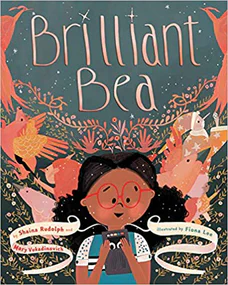Brilliant Bea
A Story for Kids with Dyslexia and Learning Differences
Written by Shaina Rudolph and Mary Vukadinovich
Illustrated by Fiona Lee
32 pages
•
Published 2021 (Magination Press)

Recommended Age Range: 1st grade through 4th grade.
Publisher's Summary:
Brilliant Bea is an endearing and empowering story that demonstrates that a learning difference like dyslexia doesn’t define who you are. Despite her struggles with reading and writing, Beatrice is a natural and brilliant storyteller. With the help of a kind-hearted teacher, Beatrice uses an old-fashioned tape recorder so she can speak her words and then play them back, as a technique for learning in a whole new way. With her new approach, Beatrice is able to show her classmates who she really has been all along.

Dr. Annie's Takeaways
Recommended for: This book is great for kids with dyslexia who have lost sight of their strengths and need a reminder that they, too, are brilliant (“bright and radiant…the opposite of dull”). This story celebrates teachers who see students’ strengths, and it highlights the importance of accommodations (in this book, a tape recorder) to help kids become “who [they] are meant to be.” The text is written in a dyslexia-friendly font (EasyReading).
Evidence-Based Practices:
Psychoeducation
Tone: Earnest, upbeat
Story Quality: This is a sweet story with a relatable protagonist, and it has a few lines adults will chuckle at (e.g., Beatrice refers to the tape recorder as an “ancient device”).
Illustrations: Cute, stylized illustrations in rich earth tones.
Representation: Bea is a biracial girl (she has brown skin and black curly hair) with dyslexia. She has a Black mom and a White dad. Her little brother has brown skin and black curly hair. Bea’s teacher, Ms. Bloom is a White woman who uses she/her pronouns. She has short hair that is shaved on the sides, and she wears traditionally masculine clothing (i.e., a short-sleeved button-up and an argyle sweater vest). Bea has a friend, Rudy, who is a White boy. Their classmates are diverse (i.e., different skin colors and genders).
Psychological Practices: This story shows kids that with appropriate accommodations and adult encouragement, their own brilliance can shine. Bea is a “brilliant” story-teller despite her dyslexia. Her parents and her little brother know this, but she hasn’t been able to shine at school. Her teacher provides her with a tape recorder, and this helps her to share her stories with her peers and to make friends. This story also validates the frustrations commonly experienced by kids with dyslexia (wanting to melt into her one’s chair when called on to read aloud, having to stay in during recess to finish an assignment), and it normalizes a dyslexia diagnosis: “Reading and writing are extra hard for me. Mom and Dad told me that’s called dyslexia.” The story ends with Bea as an adult back in Ms. Bloom’s classroom reading aloud a children’s book she wrote.
Concerns: Tape recorders–or more common these days, speech-to-text software–can really help kids and adults with dyslexia to communicate their thoughts. That said, it’s not completely clear to me how the tape recorder helps Bea in this story. It seems to give her the confidence to tell her stories (although Ms. Bloom telling her she’s brilliant likely also helped with this), and it attracts the attention of other children who then appreciate her story-telling skills, but it isn’t very clear to me how it helps her to learn, as is stated in the story (“Learning differently wasn’t something to be afraid of anymore”). This is not a big deal–I’d just make the connection between Bea’s tape recorder and whatever accommodations the child reading the story will have access to as a way to jump start a conversation about how accommodations can help kids to fully access their brilliance.
